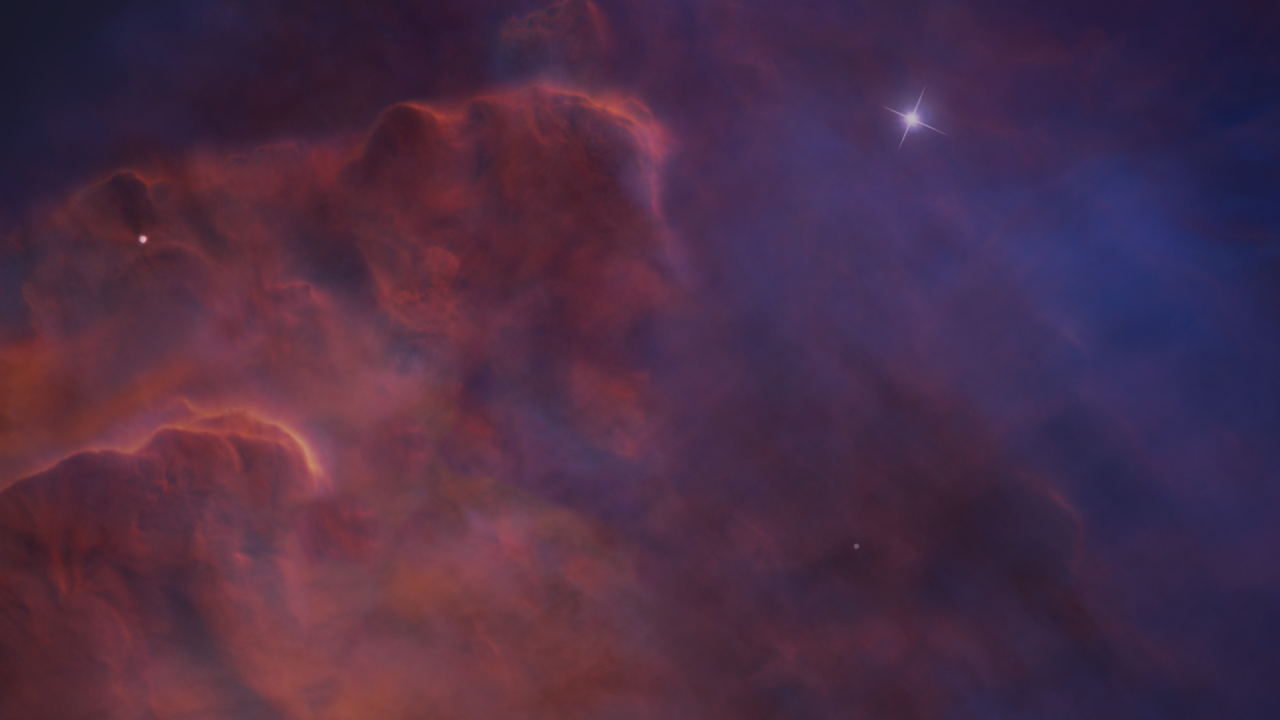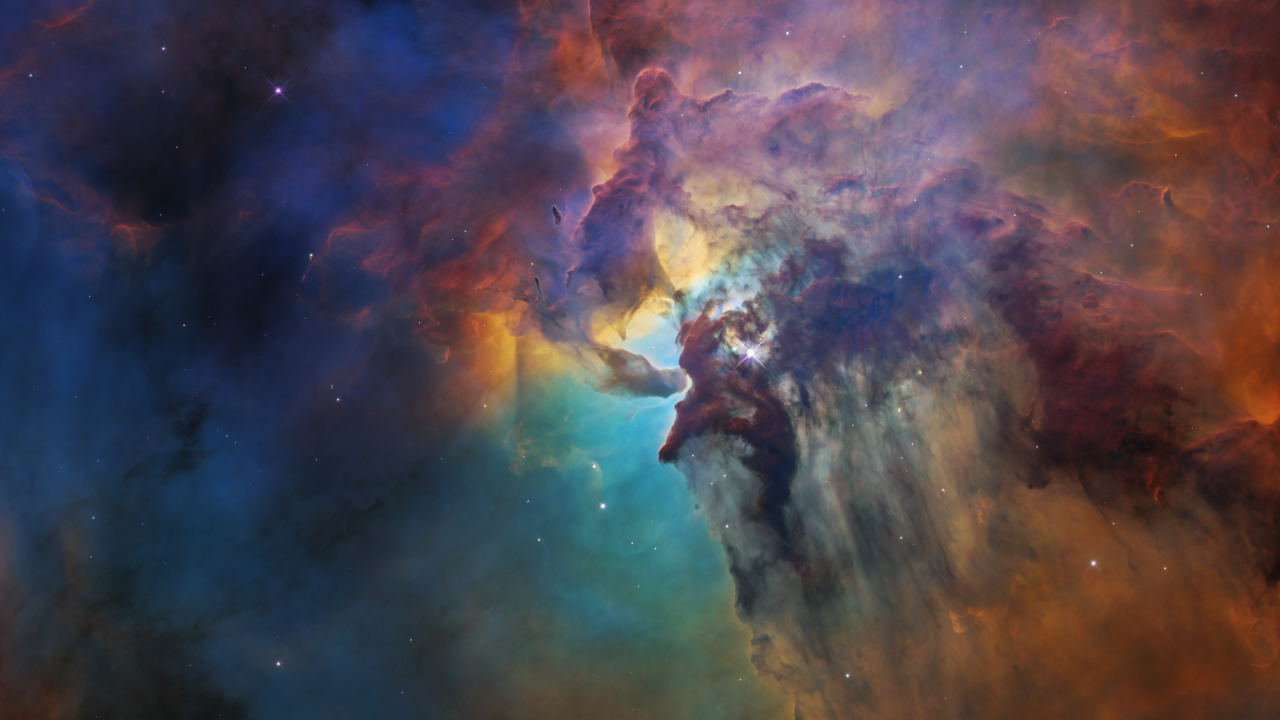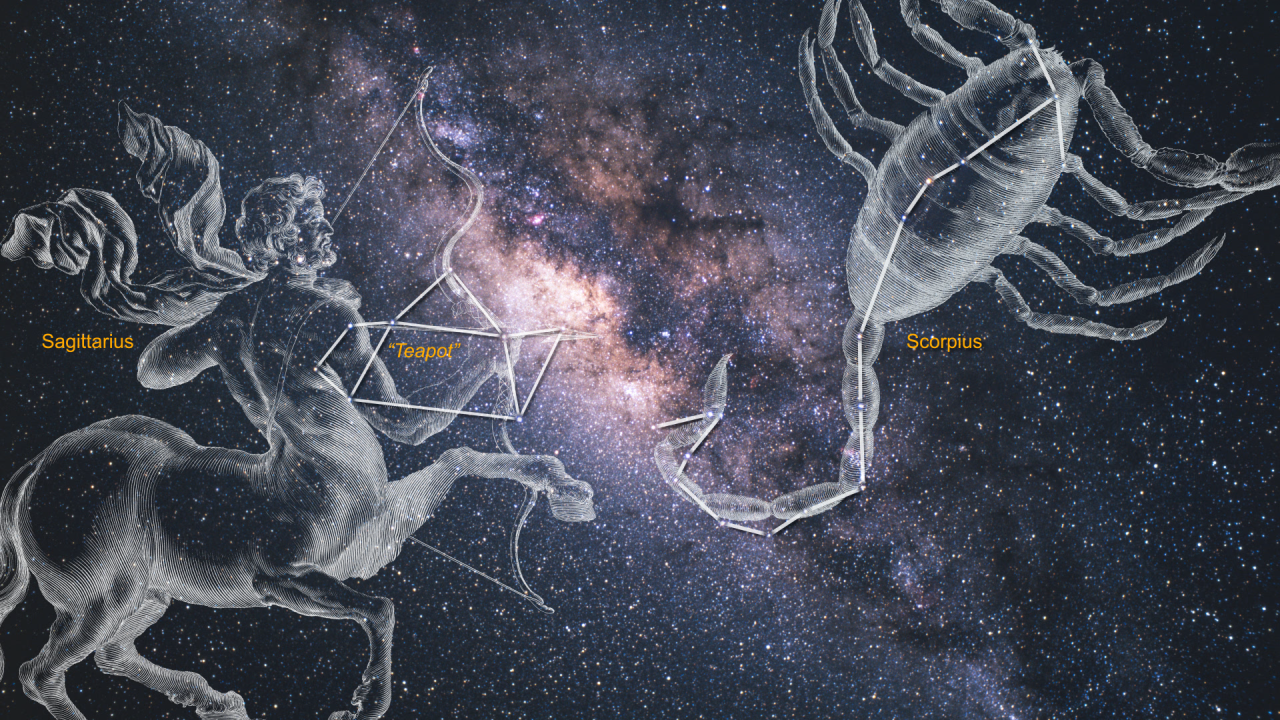1 min read
Lagoon Nebula (Visible-light View)

This colorful image, taken by NASA’s Hubble Space Telescope, celebrates the Earth-orbiting observatory’s 28th anniversary of viewing the heavens, giving us a window seat to the universe’s extraordinary tapestry of stellar birth and destruction.
At the center of the photo, a monster young star 200,000 times brighter than our Sun is blasting powerful ultraviolet radiation and hurricane-like stellar winds, carving out a fantasy landscape of ridges, cavities, and mountains of gas and dust.
This mayhem is all happening at the heart of the Lagoon Nebula, a vast stellar nursery located 4,000 light-years away and visible in binoculars simply as a smudge of light with a bright core.
The giant star, called Herschel 36, is bursting out of its natal cocoon of material, unleashing blistering radiation and torrential stellar winds (streams of subatomic particles) that push dust away in curtain-like sheets. This action resembles the Sun bursting through the clouds at the end of an afternoon thunderstorm that showers sheets of rainfall.
Herschel 36’s violent activity has blasted holes in the bubble-shaped cloud, allowing astronomers to study this action-packed stellar breeding ground.
The hefty star is 32 times more massive and eight times hotter than our Sun. It is nearly nine times our Sun’s diameter. Herschel 36 is still very active because it is young by a star’s standards, only 1 million years old. Based on its mass, it will live for another 5 million years. In comparison, our smaller Sun is 5 billion years old and will live another 5 billion years.
This region epitomizes a typical, raucous stellar nursery full of birth and destruction. The clouds may look majestic and peaceful, but they are in a constant state of flux from the star’s torrent of searing radiation and high-speed particles from stellar winds. As the monster star throws off its natal cocoon of material with its powerful energy, it is suppressing star formation around it.
However, at the dark edges of this dynamic bubble-shaped ecosystem, stars are forming within dense clouds of gas and dust. Dark, elephant-like “trunks” of material represent dense pieces of the cocoon that are resistant to erosion by the searing ultraviolet light and serve as incubators for fledgling stars. They are analogous to desert buttes that resist weather erosion.
The Hubble view shows off the bubble’s 3D structure. Dust pushed away from the star reveals the glowing oxygen gas (in blue) behind the blown-out cavity. Herschel 36’s brilliant light is illuminating the top of the cavity (in yellow). The reddish hue that dominates part of the region is glowing nitrogen. The dark purple areas represent a mixture of hydrogen, oxygen, and nitrogen.
The image shows a region of the nebula measuring about 4 light-years across.
The observations were taken by Hubble’s Wide Field Camera 3 between Feb. 12 and Feb. 18, 2018.
The Hubble Space Telescope is a project of international cooperation between NASA and ESA (European Space Agency). NASA's Goddard Space Flight Center in Greenbelt, Maryland, manages the telescope. The Space Telescope Science Institute (STScI) in Baltimore conducts Hubble science operations. STScI is operated for NASA by the Association of Universities for Research in Astronomy, Inc., in Washington, D.C.
About the Object
- R.A. PositionR.A. PositionRight ascension – analogous to longitude – is one component of an object's position.18:03:37.0
- Dec. PositionDec. PositionDeclination – analogous to latitude – is one component of an object's position.-24:23:12.0
- ConstellationConstellationOne of 88 recognized regions of the celestial sphere in which the object appears.Sagittarius
- DistanceDistanceThe physical distance from Earth to the astronomical object. Distances within our solar system are usually measured in Astronomical Units (AU). Distances between stars are usually measured in light-years. Interstellar distances can also be measured in parsecs.The nebula is located 4,000 light-years away from Earth.
- DimensionsDimensionsThe physical size of the object or the apparent angle it subtends on the sky.Image is 3.5 arcmin across (about 4 light-years).
About the Data
- Data DescriptionData DescriptionProposal: A description of the observations, their scientific justification, and the links to the data available in the science archive.
Science Team: The astronomers who planned the observations and analyzed the data. "PI" refers to the Principal Investigator.The HST observations include those from program 15449 (M. Mutchler/STScI) - InstrumentInstrumentThe science instrument used to produce the data.WFC3/UVIS
- Exposure DatesExposure DatesThe date(s) that the telescope made its observations and the total exposure time.12-18 February 2018
- FiltersFiltersThe camera filters that were used in the science observations.F502N, F547M, F656N, F658N
- Object NameObject NameA name or catalog number that astronomers use to identify an astronomical object.Lagoon Nebula (Messier 8)
- Object DescriptionObject DescriptionThe type of astronomical object.Emission Nebula
- Release DateApril 19, 2018
- Science ReleaseCelebrating 28 Years of the Hubble Space Telescope
- Credit

These images are a composite of separate exposures acquired by the WFC3 instrument on the Hubble Space Telescope. Several filters were used to sample narrow wavelength ranges. The color results from assigning different hues (colors) to each monochromatic (grayscale) image associated with an individual filter. In this case, the assigned colors are: Blue: F502N Green: F656N Red: F658N Luminosity: F547M

Related Images & Videos

Lagoon Nebula (Infrared-light View)
Hubble 28th Anniversary Image in Infrared Shows Promise of Webb Telescope This star-filled image, taken by NASA’s Hubble Space Telescope in near-infrared wavelengths of light, reveals a very different view of the Lagoon Nebula compared to its visible-light portrait. Making...

Lagoon Nebula (Visible-light View vs. Infrared View)
Two Hubble Views of the Same Stellar Nursery These NASA Hubble Space Telescope images compare two diverse views of the roiling heart of a vast stellar nursery, known as the Lagoon Nebula. The images, one taken in visible and the other in infrared light, celebrate Hubble’s 28th...

Lagoon Nebula (3D Pans)
This sequence of Hubble Space Telescope views represents an imagined three-dimensional flight across the core of the Lagoon Nebula, a rich star-birth region located in the constellation Sagittarius in the direction of our Milky Way galaxy's central bulge. The viewer sees bright,...

Lagoon Nebula (Zoom and 3D Pans)
This video zooms into the core of a rich star-birth region called the Lagoon Nebula, located in the constellation Sagittarius in the direction of our Milky Way galaxy’s central bulge. The sequence then dissolves to a series of imagined three-dimensional flights past striking...

Lagoon Nebula (Visible to Infrared Dissolve)
This video compares the colorful Hubble Space Telescope visible-light image of the core of the Lagoon Nebula and a Hubble infrared-light view of the same region. The visible-light view reveals a fantasy landscape of ridges, canyons, pillars, and mountains of gas and dust...

Lagoon Nebula (Narrated Zoom)
We begin our journey with a view of the night sky, looking in the direction of our galaxy's central bulge. We zoom into the star clouds and dark dust lanes of the Milky Way. The pink object ahead of us is the Lagoon Nebula, the birthplace of stars. As we get closer, we see a...
Share
Details
Claire Andreoli
NASA’s Goddard Space Flight Center
Greenbelt, Maryland
claire.andreoli@nasa.gov































